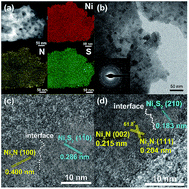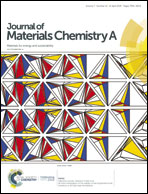Interfacial nickel nitride/sulfide as a bifunctional electrode for highly efficient overall water/seawater electrolysis†
Abstract
Simple methods for fabricating highly active and stable bifunctional electrocatalysts for water electrolysis are essential for hydrogen production. A nickel nitride/sulfide electrode (NiNS), whereby Ni3N and Ni3S2 species are interfaced, is synthesized via a one-step calcination process of Ni foam with thiourea in a vacuum-sealed ampoule. The resultant NiNS can be employed directly as a bifunctional electrocatalyst for water splitting with excellent activity toward the hydrogen evolution reaction and oxygen evolution reaction. The significant electrocatalytic performance of NiNS is attributed to the interface between Ni3N and Ni3S2, which functions as the electrochemical active sites and is beneficial for dissociative adsorption of water molecules. Current densities of 12.4 mA cm−2 and 48.3 mA cm−2 at 1.8 V are achieved for overall water electrolysis under neutral pH conditions and in seawater, respectively, when NiNS is applied as both the anode and cathode. This performance is significantly better than that of the benchmark Ir–C and Pt–C electrode system. Accordingly, interfacial NiNS is a promising bifunctional candidate for realistic large-scale water electrolysis.

- This article is part of the themed collection: 2019 Journal of Materials Chemistry A HOT Papers


 Please wait while we load your content...
Please wait while we load your content...